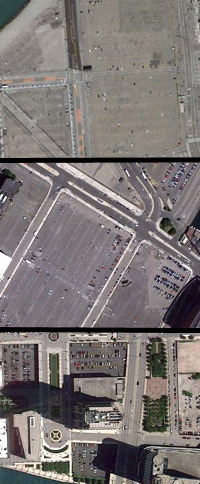 Parking lots on the fringes of downtown San Francisco, Boston and Chicago. |
Ryan Avent says he has a hard time taking my views on the height limit seriously until I honestly grapple with the trade-offs the limit involves.
Ironic, as I might say the same about him. His response to my suggestion that the height limit may have value that his strictly numbers-based approach doesn’t take into account was to repeat the same economic argument over again, as if the non-economic trade-offs don’t matter.
When I say we should raise the height limit in some places but not others, I’m balancing economic, urbanist and political needs. When Ryan says we should raise it wholesale, he’s thinking in one dimension.
Further, there are real holes in his theories about urban development. In response to my claim that the height limit induces development in areas that would otherwise be underdeveloped such as NoMa, Ryan claims that eliminating the height limit would actually lead to increased development there because it would free up marginal areas for less expensive building types.
On paper that theory might make sense, but in reality it never happens that way.
What actually happens in cities with unlimited vertical development potential is that they end up with a lot of tall towers surrounded by surface parking lots. Eliminating the height limit raises the potential land value of every parcel in a given area, so that developers can’t justify building short buildings. Instead of filling in underdeveloped parcels with whatever development fits or whatever the market calls for, builders “bank” land by leaving it undeveloped until they can justify a skyscraper. The result is that every large city in America except New York and Washington is scattered with parking lots.
If we raise the height limit, on the ground experience from every other city in the country tells us that NoMa won’t develop at all until land owners think it’s ready for skyscrapers.
This may not fit academic models of how urban economics should work, and perhaps it is illogical, but it is absolutely how things do work, like it or not.
But the biggest problem with Avent’s position is practical: Getting Washingtonians to agree to something as radical as changing the defining regulation of our city will take a more holistic approach than he seems willing to accept.
There are real trade-offs to raising the height limit that a strictly economic model doesn’t address. Trade-offs like the quality of the pedestrian experience, like how we develop the city’s neighborhoods, or like the emotional value many perceive in having a capital city where economic speculation is specifically checked in order to maintain a distinct monumental civic core. These issues matter to a great number of Washingtonians, though it may be hard to attach monetary values to them.
Ryan talks very intelligently about economics, but at its root this is not an economic question. It’s a political one, and it is not likely that Ryan’s proposals will be taken seriously by decision makers unless he grapples with the non-economic trade-offs that raising the limit involves.
I think that’s too bad, because we could be moving this discussion forward based on the common ground we do have, and figuring out how to make strategic changes to the limit actually happen. Instead we’re stuck in ivory towers on the ideological fringe, arguing in circles and hoping for a Hail Mary.
October 20th, 2010 | Permalink
Tags: law, urbandesign













